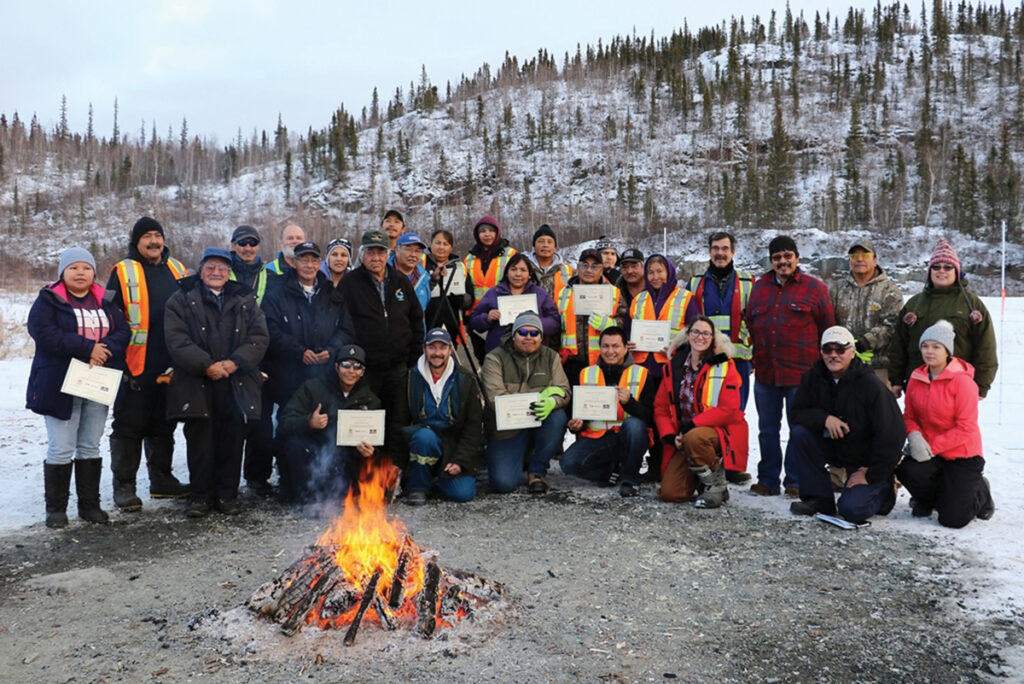Tłįchǫ Program Offers Hands-on Learning
Participants Will Have Jobs through Former Colomac Mine Community Based Monitoring

The Tłįchǫ Government, working primarily in partnership with Indigenous and Northern Affairs Canada’s Contaminants and Remediation Division (INAC-CARD) and Tłįchǫ Construction, recently held a four-week work-to-learn program at the former Colomac Mine site.
“This program builds capacity on contaminated sites as a training ground, so that graduates will have the skills and abilities to complete environmental monitoring work – before, during and after any development on the land,” said Tyanna Steinwand, Lands Regulator with the Tłįchǫ Government. “Graduates and a new crop of trainees will be involved in community based monitoring at Colomac as of 2018.”
The schedule for the Colomac work-to-learn program was broken into two parts, with student-workers from Whati and Gameti working in two-week rotations.
The program offered an introduction to environmental monitoring and students were provided on-the-job training in care and maintenance type work in addition to decommissioning monitoring wells and operating equipment such as mini-excavators. The students provided assistance toward the installation of water monitoring stations, which send real-time updates on the status of water and wells. They also completed a wetland barrier, finished off infrastructure repairs and performed maintenance on the existing berm, which was designed to keep wildlife out of the tailings pond.
To celebrate their hard work, three community elders – Noel Drybones, Behchokǫ̀; Louis Zoe, Gamètì; and, Joe Champlain, Whatì – joined them at the site where a Feeding of the Fire graduation ceremony was held, during which students received completion certificates. Graduates included Albina Nitsiza, Alfred Flunkie, Archie Zoe, Donovan Romie, Eileen Mantla, Eric Zoe, Forrest Blackduck, Gerrick Moosenose, Kevin Crookedhand, Lisa Marie Zoe, Louisa Nitsiza, Mary Chocolate, Peter Nitsiza, Robert Nitsiza, and Tracella Romie.
To ensure everyone’s safety during the course Frank Camsell, Frankie Joe Nitsiza, Freddy Simpson and Richard Romie were hired on as wildlife monitors by Tłįchǫ Construction.
“This is an exciting partnership between the Government of Canada and the Tłįchǫ Government, and everyone involved is working to continue to strengthen community capacity on these projects,” added Steinwand. “There could be other developments in the area such as the proposed Tłįchǫ All Season Road that these grads are now better prepared to apply for jobs on.”
Camp Life Not New
Steinwand explained that some of the students had prior exposure to working at remote sites so it wasn’t exactly an unfamiliar experience staying in a camp for two weeks.
“They befriended their instructors and everyone seemed to enjoy themselves out there,” she said. “They did however run out of work towards the end (because they were so efficient!) and were therefore eager to get home.”
Students were able to try and master new skills, which she said was a great confidence builder. Organizing the logistics of the program was a challenge especially with setting up a camp in short notice, but their corporate partners Tłįchǫ Construction and Discovery Mining Services were extremely helpful and efficient in getting everything ready in time.
The Colomac work-to-learn program cost approximately $700,000 and was funded by the Government of Canada. INAC-CARD and the Tłįchǫ Government worked in partnership to facilitate the program. Indigenous and Northern Affairs Canada provided logistical support and contracted Stantec to provide environmental oversight and reporting. The Tłįchǫ Government contracted Tłįchǫ Construction as the primary contractor and instructors for the students.
“All groups worked closely together for the length of the project to ensure the success of the program,” she concluded.

